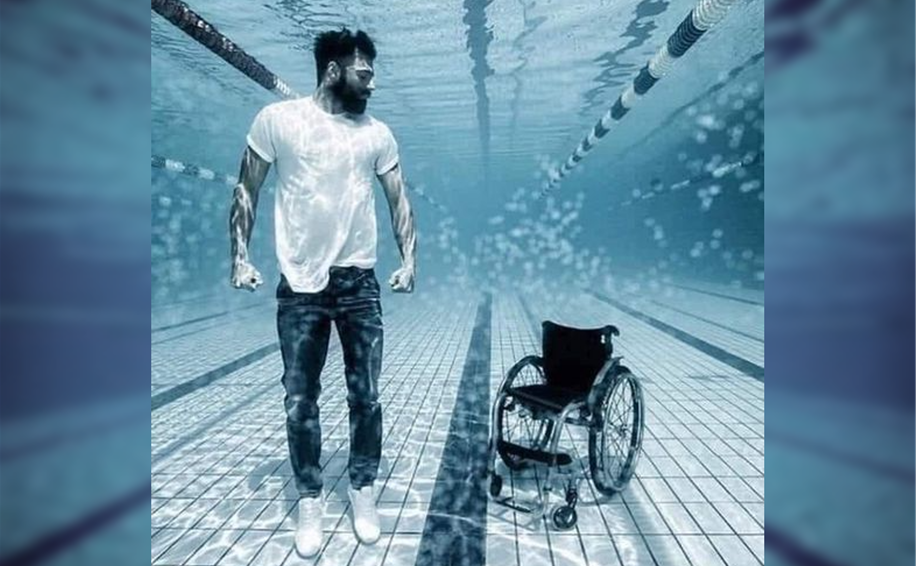Just a quick announcement to anyone reading this: I loathe images like this one.
Let me give you three reasons why.
This image was recently shared on a public Facebook page called Wonder of Nature. It was highlighted and captioned as “♥The power of water. The most beautiful photo you’ll see today♥.”
Over 650,000 people reacted to this post with likes, hearts, or care emojis. It garnered over 34,000 shares and 4,000 comments about miracles and condescending language about how the “world can’t hold him down!”
First of all, on a purely literal level, this image is not beautiful. It is horrifying.
If someone in a wheelchair fell into a deep pool of six feet of water, they might drown. This image suggests that physically standing is beautiful and an empty wheelchair symbolizes success, idealizing and romanticizing while erasing what could be a real threat to life.
And I can absolutely guarantee the final thoughts of the wheelchair user would NOT be musing “oh wow, it looks like I’m standing, how beautiful, I am free!”
It would be just the opposite: fear.
Without a wheelchair, this person might not be able to move independently, rendering this a terrifying situation. It’s ableist to view walking or standing as the goal. It’s ableist to view mobility aides as anything less than independence.
Second, the caption under this image reads “the most beautiful thing you’ll see today.” Ask yourself, why is it beautiful to you to see a wheelchair user standing outside of their chair? Does it make you uncomfortable to see someone with a visible disability?
Wheelchairs and other mobility aides should not be looked at as though they are the worst thing in the world. Unfortunately, for many decades the mainstream media has portrayed people with disabilities who use wheelchairs and walkers as sick, elderly, impoverished, and a burden. People with physical disabilities are regarded as enfeebled noncontributors who need to be taken care of.
But far from being something that holds people with disabilities back, mobility aides mean independence, access, and inclusion.
Walkers, arm canes, rollators, and wheelchairs are aides that assist individuals with physical disabilities with movement. We think nothing of someone who uses glasses to see clearly. But a troubling stigma attaches to being a wheelchair user: others should feel sorry for this person. This response assumes that the best life, the life worth living, is the life where you can walk.
Wheelchairs assist my husband Patrick, who was born with cerebral palsy, to parent our three children, to perform work duties, to drop our children off at school, to grocery shop, and to run errands. His wheelchair helps him to conserve energy while doing all these tasks, enabling him to be an active community member and husband. Wheelchairs allow him to participate in life fully.
It is important and critical for everyone to see positive examples of disability representation in the media. Our children’s toy room houses countless doll-sized wheelchairs. It has a bookshelf with many books that feature wheelchairs and characters with disabilities. My children frequently play with Lego characters who have small athletic sport wheelchairs or Barbies with a monoskis and outriggers.
With our children, Patrick and I make a point to highlight that people with disabilities are athletes, professionals, and live full lives not in spite of their disabilities, but because they have equipment and accommodations that foster participation.
We should promote that when we design spaces with universal accessibility and use technology and ingenuity to create tools and adaptations, we create a world where everyone can play on a level field. These are urgent democratic principles.
Lastly, if my arguments have touched you or maybe even opened your eyes about disability representation, please don’t share images like this on social media or on email. Stop yourself. Stop images like this which produce ableist fantasies from going viral.
Instead, educate yourself on disability. Most importantly, share that information with someone else and raise awareness one person at a time.
Don’t focus on the “super crip” stories where someone climbs Everest or the “inspiration porn” where someone gets asked to prom despite having Downs Syndrome. Redirect yourself to stories about people with disabilities living their everyday lives, creating a more inclusive world in the process.
You can start with learning about the history of the Disability Rights Movement, the Capitol Crawl, and other events leading up to the Americans with Disabilities Act in 1990. You can learn about para-athletes and follow the paralympic games which never seem to get media coverage. You can learn about the ways in which you can recognize your own ableism in the workplace, community, and at home.
Refuse to perpetuate the notion that you are better, healthier, and more beautiful if you are able-bodied and don’t need a wheelchair.
Using a wheelchair or walker or arm canes, or any other kind of mobility assistance isn’t sad and isn’t bad. Dispose of those thoughts and move beyond them.
Instead, rewire your ableist thinking: mobility aides are freedom and independence! So do your part to rethink wheelchairs and other mobility aides. Do not share this image!
Ashley Bohn is a communications professional at Cornell University and a passionate disability advocate in upstate NY. She lives with her WHEELY awesome husband and their three tiny advocates-in-training.

